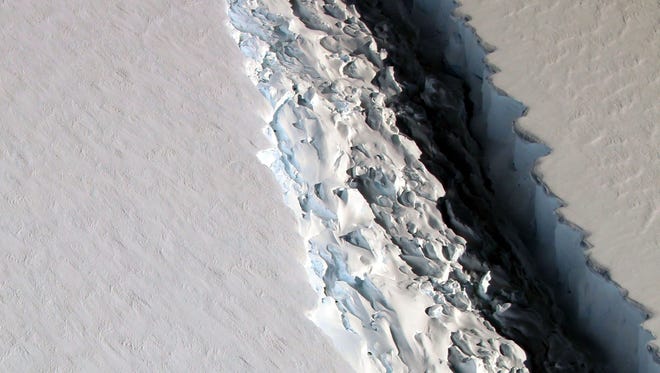Giant iceberg set to break off of Antarctica
A giant iceberg larger than Rhode Island is set to break off of Antarctica, British scientists announced Friday. If it occurs, it would be one of the biggest icebergs on record.

Scientists have been keeping a close eye on a crack in an Antarctica ice shelf that could break off, creating an iceberg and indirectly lead to rising sea levels.
The crack grew by 11 miles in December. Only a final 12 miles of ice now connects the iceberg to its parent ice shelf, according to Project MIDAS, a British Antarctic research project.
The crack in the Larsen C Ice Shelf is more than 1,000 feet wide and has grown by 50 miles since 2011, according to the British Antarctic Survey. Once the crack goes all the way across, the iceberg will break off.
"If it doesn't go in the next few months, I'll be amazed," project leader Adrian Luckman of Swansea University told BBC News. It would be among the top 10 biggest icebergs ever recorded.
"There’s no need for alarm," however, according to a tweet from Project Midas. "This is a fairly normal event, although it is spectacular and quite rare," the tweet said.
Global warming may have caused the likely separation of the iceberg but the scientists say they have no direct evidence to support this, the BBC said.
Ice shelves are permanent floating sheets of ice that connect to a landmass, according to the National Snow and Ice Data Center.
Most of the world's ice shelves hug the coast of Antarctica. The Larsen C shelf is on the Antarctic Peninsula, the portion of the continent that juts out toward South America.
If the iceberg did break off, it wouldn't contribute to sea-level rise since it's already floating, said Ted Scambos, a scientist with the data center. If a chunk of ice that big did drop into the sea, it would raise sea levels about one-sixteenth of an inch, he said.
However, once that iceberg breaks off, land ice that had been blocked by the berg would plop into the sea. It's that ice that would raise sea levels, NASA scientist Thomas P. Wagner said.
"Ice shelves serve a critical role in buttressing ice that's on land," he said.
Once the iceberg sheared off, it would float along the coast of Antarctica, then head out into the Southern Ocean.
"As it moved north, ocean temperatures both at the surface and at the base of the berg would begin to thin it and erode it from the edges," Scambos said. It would eventually break apart into smaller chunks that would melt into the ocean.
